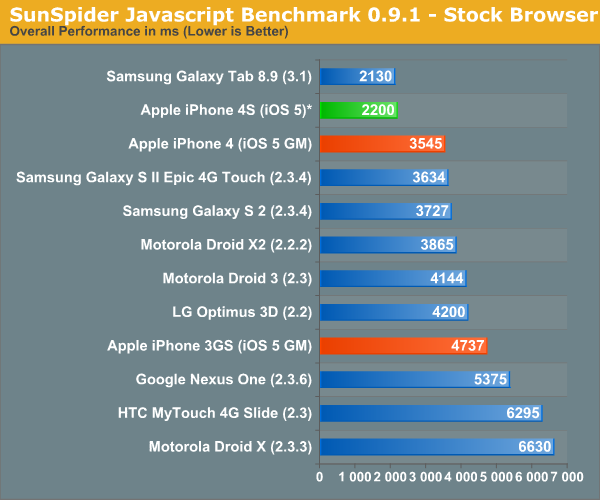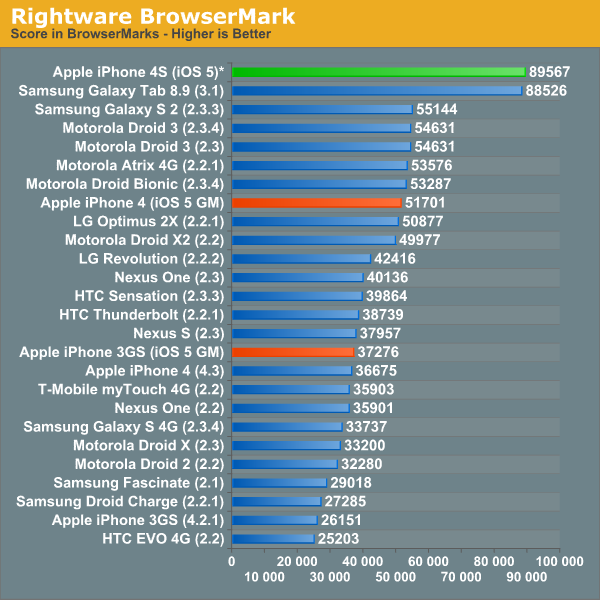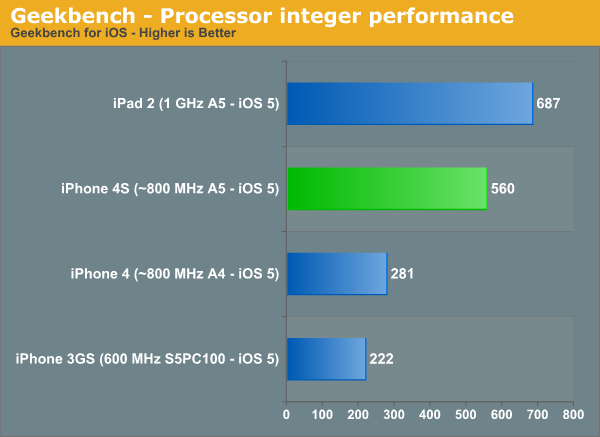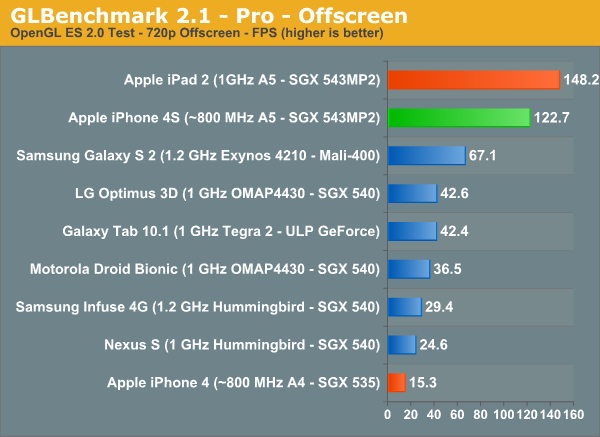iPhone 4S Preliminary Benchmarks: ~800MHz A5, Slightly Slower GPU than iPad 2, Still Very Fast
by Anand Lal Shimpi & Brian Klug on October 11, 2011 3:22 AM EST- Posted in
- Smartphones
- Apple
- Mobile
- iPhone 4S
- SoCs
Apple's ability to control the entire information chain, down to the point of limiting leaks, appears to be gradually slipping as it grows as a company. Case in point are the numerous hardware and performance leaks surrounding the newly launched iPhone 4S. Little did we know that several weeks ago we were staring at photos of the 4S' PCB, and more recently we've seen the first performance results from Apple's first A5 based smartphone thanks to a few eager users around the web. We've compiled these results here from various sources (all linked below) and compared them to our existing database of tests.
The results are pretty much as expected. Javascript performance finally catches up to Tegra 2 based Honeycomb devices, while general CPU performance is significantly higher than the iPhone 4. I suspect Ice Cream Sandwich will bridge the Android smartphone gap (the Honeycomb equipped Gtab 8.9 is here to give you an idea of where a more modern Android browser ends up).
Keep in mind that all of these tests measure performance of the software stack in addition to the hardware. In particular the web browser tests depend largely on browser optimizations, which is why we see differences between similar hardware running different browser versions. Also note that all results were run at stock, with the stock browser. Finally, although these browser tests were captured on video we'll still be running our official tests once our 4Ses arrive and will update accordingly.


Using some of the integer and fp tests of published Geekbench scores we can already conclude that Apple is shipping a lower clocked A5 in the iPhone 4S than it does in the iPad 2. This naturally makes sense as the iPhone 4S has a much smaller 5.25 Whr battery. Based on the Geekbench results it looks like the iPad 2 is clocked around 25% higher than the iPhone 4S, pegging the latter's clock speed at 800MHz.


A lower clock not only means higher yields from the factory, but likely a lower operating voltage as well. Dropping a CPU's core voltage, yields a greater-than-linear decrease in power consumption, making the marginal loss in clock speed a good choice. At a lower operating frequency than its Android competitors, Apple does have to exploit its strengths in software to avoid any tangible performance penalties. Apple has traditionally done this very well in the past, so I don't expect the loss of frequency to be a huge deal to the few who do cross-shop iOS and Android.
Unsurprisingly, memory bandwidth doesn't appear to have gone up either compared to the iPad 2's A5 (taking into account scaling due to CPU clock increases). The Samsung part number on the iPad 2's A5 indicates two LPDDR2-800 die on package, it's safe to assume that whatever Apple clocked the memory interface at in the iPad 2 remains unchanged in the iPhone 4S.
The GPU results tell a similar story courtesy of some early GLBenchmark 2.1 results. The 960 x 640 results are useless as they are bound by vsync at ~60 fps. Luckly GLBenchmark 2.1 added an off-screen render mode at 1280 x 720 where we can really see the differences between the iPad 2 and iPhone 4S A5 implementations:


Here the iPad 2 holds a ~21% performance advantage, which once again I assume to be all related to clock speed. Also note the huge advantage over the existing iPhone 4. The GPU power in the 4S should be more than enough to run any well written, current generation title at well north of 30 fps on its display.
We'll be reviewing the iPhone 4S in the coming weeks, stay tuned!
Source: GLBenchmark Database, Geekbench Database, Macrumors










216 Comments
View All Comments
doobydoo - Sunday, October 16, 2011 - link
You should include iPad 2Tomne - Tuesday, October 11, 2011 - link
Well, read th other comments on this topic. You'll see that the numbers aren't what they really are. The benchmarks are not accurate at all.doobydoo - Sunday, October 16, 2011 - link
They are accurate, it's just the fandroids don't like them.kebab77 - Tuesday, October 11, 2011 - link
http://www.bestsmartphone.com/2011/09/26/javascrip...... very different numbers, also nicely shows the difference between stock browsers and 3rd party browsers.
Anand Lal Shimpi - Tuesday, October 11, 2011 - link
We've corrected the numbers above :)Take care,
Anand
kebab77 - Tuesday, October 11, 2011 - link
Check out these figures ... I get very similar ones on my S2:http://www.bestsmartphone.com/2011/09/26/javascrip...
Chudilo - Tuesday, October 11, 2011 - link
iOS has a GPU accelerated UI.Android's browser / JavaScript performance will not be anywhere near those scores until they move the Browser interface itself off to the GPU.
As of right now Google is denying that it is something that is needed for the android OS.
shompa - Tuesday, October 11, 2011 - link
This is the difference between a "closed" and "open" platform.30% of A5 die area i NEON SIMD/Apples "visual engine". Apple can accelerate its OS with these instructions since they control the graphic layer on the phone. Android can't do this since Google does not control the graphic layer.
This is one of the reasons why A4 class devices only have been 5-10% slower then dual core Android phones.
Microsoft WinMobile takes the middle road between Apples "closed" system and Googles "open" system. MSFT have locked down what hardware telephone manufactures can use. Therefore they can accelerate the OS with GPU/SIMD.
It is also fun reading this thread.
Androids browser scores are so bad because 2.3 only use one core?
Apples scores are to good to be true?
"Samsung" CPU inside A5? (no. A5 is designed with ARM cores by Apple. A5 is 30% larger then Tegra2. Apple can use this area for better memory interface, NEON SIMD and other stuff.
"I want LTE". Why have 50 megabit on your phone? Downloading blu rays to it?
"The 3G spectrum is to crowded" No. This is not the problem. This is a USA specific problem since AT &T only have 1/3 of the Cell density they should have. (I worked at Ericsson radio system who supply base stations) This is the reason for poor reception, dropped calls. AT&T tells us that they don't get building clearance for more towers. Maybe true. But AT&T also saves billions by only deploying 1/3 of the recommended base stations. If any phone company does the same with LTE, you will have the same problem"
LTE telephones today have 50% less battery time. With 28 nm manufacturing LTE will have same battery time as 3G. This is also the reason why iPhone 5 was not released. The iPhone 5 late prototypes are ready. (teardrop design). When TSMC gets its manufacturing on track, Apple finally can technically release the Iphone5.
Tegra3 to the rescue? Yes. Tegra 3 had been interesting if it was released in August as planned. Now its late Q4. How fun is it with quod core on 45nm? Cortex9. 50% less battery time if clocked at the same speed. Early next year we are going to have good 28nm quod core with ARM15. About twice the performance of Cortex9.
I also hope that this article open peoples eyes. 1.5ghz is not always faster then 800mhz. It is about CPU/GPU design + how the OS work. Same with cameras. More megapixels does not mean better pictures.
Tech nerds seems to believe that. PC home builders and Android rom optimizers. Something that 95% of the marked does not care about.
deV14nt - Wednesday, October 12, 2011 - link
I hate to break it to you, but the A5 most certainly is made by Samsung. Maybe in the future it will be TSMC. But it will never be Apple.doobydoo - Sunday, October 16, 2011 - link
No it isn't. It's an Apple designed chip.